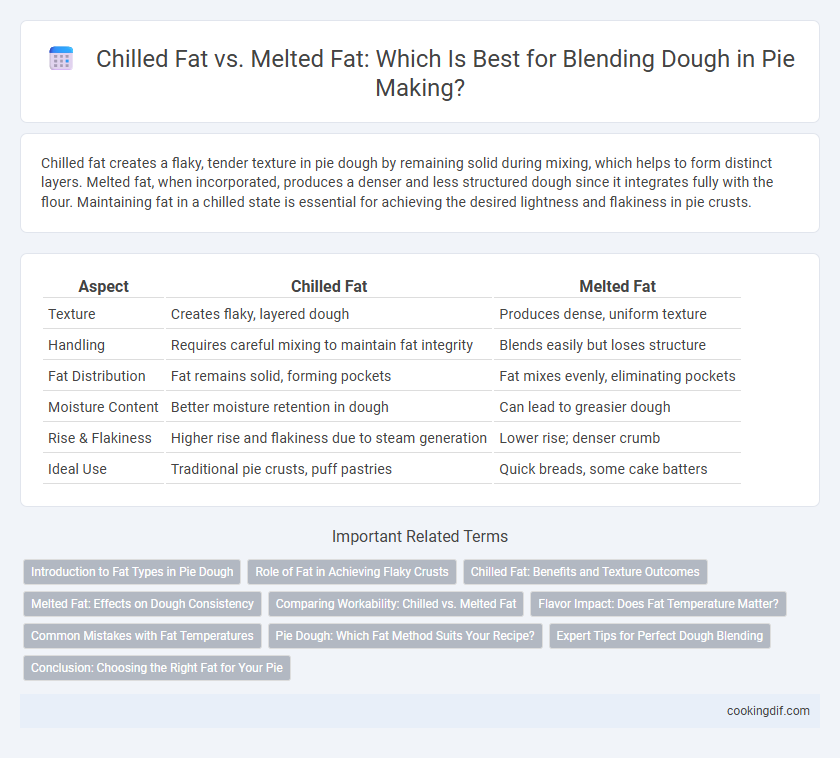Chilled fat creates a flaky, tender texture in pie dough by remaining solid during mixing, which helps to form distinct layers. Melted fat, when incorporated, produces a denser and less structured dough since it integrates fully with the flour. Maintaining fat in a chilled state is essential for achieving the desired lightness and flakiness in pie crusts.
Table of Comparison
| Aspect | Chilled Fat | Melted Fat |
|---|---|---|
| Texture | Creates flaky, layered dough | Produces dense, uniform texture |
| Handling | Requires careful mixing to maintain fat integrity | Blends easily but loses structure |
| Fat Distribution | Fat remains solid, forming pockets | Fat mixes evenly, eliminating pockets |
| Moisture Content | Better moisture retention in dough | Can lead to greasier dough |
| Rise & Flakiness | Higher rise and flakiness due to steam generation | Lower rise; denser crumb |
| Ideal Use | Traditional pie crusts, puff pastries | Quick breads, some cake batters |
Introduction to Fat Types in Pie Dough
Chilled fat in pie dough creates a flaky texture by remaining solid and forming distinct layers during baking, while melted fat results in a denser, more uniform crumb due to its evenly distributed fat content. Common fat types include butter, shortening, and lard, each contributing unique flavors and textures based on their melting points and moisture content. Understanding the role of chilled versus melted fat is essential for achieving the desired pie crust consistency and mouthfeel.
Role of Fat in Achieving Flaky Crusts
Chilled fat in dough remains solid during mixing, creating distinct layers that result in flaky crusts by preventing gluten development and allowing steam to form pockets. Melted fat, conversely, blends fully with flour, producing a tender but denser crust lacking the characteristic flakiness. For optimal flaky pie crusts, maintaining chilled butter or shortening ensures visible fat layers that separate dough strata during baking.
Chilled Fat: Benefits and Texture Outcomes
Chilled fat in pie dough creates distinct layers that produce a flaky, tender texture by slowly melting during baking, which traps steam and separates the dough. Its solid state ensures less gluten formation, resulting in a more delicate and crumbly crust. Using chilled fat also helps maintain dough integrity, preventing excessive spreading and achieving consistent volume and structure.
Melted Fat: Effects on Dough Consistency
Melted fat in dough blending significantly alters dough consistency by creating a softer, more pliable texture compared to chilled fat. It disperses more evenly within the flour matrix, leading to reduced gluten development and a tender crumb in the finished pie crust. This results in a delicate, melt-in-the-mouth quality ideal for flaky pastry layers.
Comparing Workability: Chilled vs. Melted Fat
Chilled fat maintains solid state particles that create distinct layers in dough, resulting in flakier textures and easier handling during blending. Melted fat integrates fully with flour, producing a denser dough that is less elastic and harder to work with due to decreased gluten development. Bakers often prefer chilled fat for superior workability and optimal pie crust flakiness.
Flavor Impact: Does Fat Temperature Matter?
Chilled fat in dough blending creates distinct layers that contribute to a flaky texture and a richer, more nuanced flavor profile as the fat slowly melts during baking. Melted fat results in a denser, less flaky pastry with a more uniform taste, often reducing the complexity of flavors due to the absorption of fat into the flour before baking. The temperature of fat significantly impacts the final pie crust's flavor and texture by controlling how fat interacts with flour proteins and moisture.
Common Mistakes with Fat Temperatures
Using chilled fat instead of melted fat in pie dough helps create a flaky texture by preventing excessive gluten development. A common mistake is incorporating melted fat, which results in dense, greasy crusts due to overworked dough and loss of air pockets. Maintaining cold fat pieces allows for better layering, ensuring a tender and crisp pie crust.
Pie Dough: Which Fat Method Suits Your Recipe?
Chilled fat in pie dough creates a flaky texture by maintaining solid fat pockets that release steam during baking, resulting in air pockets. Melted fat yields a denser, more uniform crumb but lacks flakiness, making it ideal for tender, cookie-like crusts or non-traditional pies. Choosing between chilled and melted fat depends on your desired crust texture: flaky and layered with chilled fat or tender and cohesive with melted fat.
Expert Tips for Perfect Dough Blending
Chilled fat, such as cold butter or shortening, creates flakier pie crusts by staying solid during mixing, which forms distinct layers and prevents overworking the dough. Melted fat produces a denser, less flaky texture as it fully integrates into the flour, reducing the dough's ability to puff and separate. Experts recommend using chilled fat for pie dough to achieve optimal texture and structure through precise blending techniques.
Conclusion: Choosing the Right Fat for Your Pie
Chilled fat creates a flaky, tender pie crust by maintaining solid fat pockets that release steam during baking, resulting in light layers. Melted fat produces a denser, less flaky texture due to uniform fat distribution throughout the dough. For optimal pie crust quality, use chilled fat to achieve the desired flaky structure and buttery flavor.
Chilled fat vs Melted fat for dough blending Infographic

 cookingdif.com
cookingdif.com